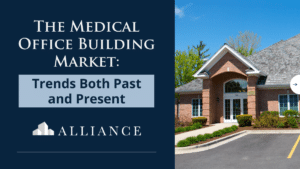Investing in Healthcare Real Estate: The Keys to Success
The healthcare industry is rapidly evolving, and in turn, demand for certain types of medical properties is changing. As a result, Healthcare real estate continues to be a valuable addition to any investor’s portfolio. This is especially true among real estate investors looking to diversify away from more traditional commercial real estate products like multifamily, office, and retail.
However, people are cautioned not to invest in healthcare real estate blindly. The sector has many nuances that investors should consider. These nuances will impact healthcare real estate assets’ ultimate viability (and profitability).
This article looks at the keys to successful investing in healthcare real estate.
Subscribe to our commercial real estate newsletter.
Why Invest in Healthcare Real Estate
Healthcare real estate was once considered a niche that only drew attention from those with some medical expertise. That is no longer the case. The industry’s strong underlying fundamentals, positive growth trajectory, and continued resiliency make healthcare real estate attractive to investors of all kinds.
Consider the following data recently published by advisory firm Marcus & Millichap:
- 7 million people will turn 65 this year, a 3% increase from the year prior. All Baby Boomers will have reached age 65 or older by 2030. As people age, their need for medical care dramatically increases.
- The supply of medical office real estate remains constrained. Industry experts predict only 1.0% growth in inventory this year, with 70% of projects slated for completion already having tenants in hand.
- Medical office rents have increased for nine consecutive years in a row, with the national asking rate for newly built space up 1.6% even during the depths of the pandemic.
- A flood of investor interest in medical offices had led to record trading. In the 12 months ending in March 2020, medical office closing accounted for nearly 30% of allS. office sales, up 9% from the average rate between 2015 and 2019.
For these reasons, investors are flocking to the medical office sector with growing speed. But again, investors should take the time to understand the drivers that will make their healthcare real estate assets most lucrative.
Keys to Successful Investing in Healthcare Real Estate
Healthcare systems, institutional investors, and smaller mom-and-pop landlords (many of whom have a medical background) have historically been the primary investors in healthcare real estate. However, ownership has become more fragmented, with more players entering the fray. As a result, first-time medical office investors learn the keys to successfully investing in healthcare real estate firsthand.
Here are the top 5 keys to successfully investing in healthcare real estate.
Choose a location carefully.
As the old adage goes, “location, location, location!”. But, at the risk of being overdone, it’s important to note that location is critically important to the viability of healthcare real estate – just as it is vital for other commercial real estate pursuits.
There are specific locational considerations for healthcare real estate, though.
At a high level, real estate investors will want to monitor demographic trends closely before deciding where to invest in medical office buildings. The Sunbelt states, in particular, are experiencing tremendous growth given an influx of retirees moving to the area. This bodes well for those investing in medical office real estate in places like the Carolinas, Arizona, New Mexico, Texas, and Florida.
Demographic trends should be monitored closely, however. Looking at population growth alone is insufficient. Investors will want to consider additional characteristics of healthcare users in the trade area, such as the estimated breakdown of insurance coverage, lifestyle characteristics, and potential demand for the service lines that are most likely to occupy the medical office building.
More locally, investors will want to focus their attention on medical office buildings that are centrally located, highly visible, and provide easy access.
A big misconception is that “if you build it, they will come,” but that’s proving not to be the case for all medical office properties.
Instead, investors should look at properties close to established community service facilities, business centers, shopping centers, dense residential neighborhoods, long-term care facilities, and transportation hubs. These locations tend to be preferred among today’s healthcare consumers, who find tremendous value in bundling their errands into a single trip and, ideally, to a single and convenient location.
Visibility and access are equally important. Properties that are located along major thoroughfares, with prominent signage, and that can be easily accessed by multiple modes (primarily cars, but also pedestrians, bicyclists, and transit users) are ideal. In addition, visibility and access become more critical when catering to an aging demographic.
Related: The Value of Lease Renewals
Ensure the site has proper infrastructure.
Many would argue that it’s easier and more efficient to purchase an existing medical office building versus investing in the ground-up construction of a new facility. And while this may be true, especially in light of time-to-market considerations, there are some challenges that investors will encounter when buying existing facilities—especially if those are outdated.
Investors need to conduct thorough due diligence on a site’s infrastructure. Infrastructure includes but is not limited to sufficient parking, ADA accessibility, modern building systems, and floor-to-floor heights and floor plan layouts that are conducive to today’s medical office tenants.
For example, today’s medical office buildings are generally designed with some of the key characteristics:
- 9-foot ceilings are considered the minimum standard for medical office buildings. Tenants also prefer at least 6-foot-wide multi-tenant corridors.
- Surgical suites are generally best placed on the top floors of medical office buildings where ceiling heights may be higher. This additional height is often necessary to accommodate specialized HVAC equipment needs.
- Typical floor cores typically feature fewer common bathrooms than would be expected per code, given that most medical tenant suites provide their own restrooms.
- Medical gas delivery and storage areas are often required in the central loading area.
- Imaging and other treatment equipment may require lead lining or on-grade locations to allow radiation to penetrate the soil and prevent penetration to tenants on floors below.
- Medical office buildings should typically have at least 5.0 parking spaces per 1,000 gross square feet. However, some tenants will look to have at least 6.0 spaces/1,000 GSF. In addition, there will need to be more handicapped-accessible parking spaces, depending on the nature of the facility.
Whether evaluating an existing site or new construction, investors will want to ensure the site provides adequate infrastructure such as that noted above. Otherwise, it may require costly investments in the future for the facility to remain competitive in the marketplace.
Design medical office buildings flexibly.
The healthcare industry is changing before our eyes. For example, telehealth was not a serious consideration among most providers pre-pandemic. However, today, some specialties (e.g., behavioral health) continue to utilize telehealth as a primary way to conduct their visits.
Similarly, changes made via the Affordable Care Act now allow medical providers to store patient records electronically. The practical implication is that the large, costly medical record storage rooms that healthcare providers once needed to lease space are no longer required. Instead, these storage rooms can now be reimagined, repurposed, and released for higher revenue-generating needs.
Moreover, the pandemic has proven that it’s possible for some back-office functions, such as medical billing, to be conducted remotely. If some employees are able to continue working from home indefinitely, this will change the need for traditional office space within medical office buildings. We can also reimagine those spaces for other, higher revenue-generating uses.
These industry changes do not even begin to touch upon the technological advancements occurring in the healthcare industry, which may also impact the design and use of medical office buildings. For example, digital imaging can now be conducted via satellite, which may reduce the need for this equipment in some MOB facilities—but could simultaneously create demand for standalone imaging centers that investors can add to their real estate portfolios.
In any event, investors will want to consider medical real estate that provides some degree of flexibility as the healthcare sector evolves. Changing care delivery models may necessitate this flexibility, and properties that can accommodate these changes will be best positioned to thrive into the future.
Related: Technology & Real Estate Trends
Look at how buildings can improve the patient experience.
One healthcare trend to watch closely is the increased demand for elective procedures. Many elective procedures are paid for out of pocket, often costing the patient thousands of dollars (or more!). These patients, especially, will be looking for medical office facilities that provide a comfortable and relaxing environment.
There are many ways for MOB owners to improve the patient experience.
One strategy is to focus on the building exterior, lobby, and waiting room areas. They say first impressions are everything, and these building components are among the first to see as a patient enters a MOB facility. Waiting rooms, for example, should be inviting and comfortable. Chairs should have good back support and sturdy arms, especially if catering to an older population. Many patients want to be productive during their wait, so free and high-speed Wi-Fi is particularly important today.
Offering coffee, water, and an assortment of healthy snacks is another way to improve the waiting room experience.
Another way to improve the experience is by bringing the outdoors in. Studies dating back decades show that patients recovering from surgery have shorter stays and need less medication when their rooms have views of trees and other green spaces versus parking lots or building walls. Even artwork that depicts nature has proven to have a positive impact on patient outcomes. Today’s healthcare facilities should take cues from the hospitality and spa industry by integrating natural materials, water elements, and other nature-inspired touches into their design.
Have a proper advisory team in place.
Given the nuances associated with healthcare real estate, investors need to have a strong advisory team in place. This is true, especially when considering purchasing a medical office building directly (instead of investing alongside an adept real estate sponsor). For example, someone who lacks MOB investing experience may assume they can construct a certain type of healthcare facility without realizing what city or state permits may be needed in advance.
It is also important to have architects, engineers, and designers on your team who have healthcare experience as these facilities are unique compared to other commercial real estate product types.
Many real estate investors will find that the best strategy is to invest in syndication or a fund that is spearheaded by a sponsor with decades of healthcare experience. This is one of the best ways to guarantee a healthy, viable investment opportunity. An experienced MOB sponsor, for example, will have a strong grasp on both the macro and micro-level considerations that will influence investors’ projected returns. They will know how to build a team of the right professionals and will select team members based on the specifics of any deal under consideration. They will then craft the most appropriate business plan for that asset, including but not limited to how best to finance the deal, improve the asset, stabilize the asset and increase net operating income during the hold period.
Just like a quarterback propels a football team forward, so too will an adept real estate sponsor. Teaming up with the right people is key to achieving maximum capital growth and increasing return potential.
Healthcare Real Estate Investing For Your Future
Investing in medical office real estate can seem daunting to those who have not invested in the space before. While there are unique challenges to consider, there are also many opportunities – especially for those who invest now as an otherwise niche sector grows.
Today’s healthcare sector is booming and shows no signs of slowing down. That makes healthcare real estate well-positioned for significant appreciation in the years to come, especially as more investors compete to add these properties to their portfolios.
If you’re interested in investing in medical office real estate, contact us today. Our team will talk you through our investment strategy and can discuss whether our platform is appropriate for your personal investment goals and needs.
POSTED BY
Ben Reinberg
Founder & CEO | Alliance Group Companies

Ben Reinberg is Alliance Group Companies' founder and CEO.
Since 1995, Alliance Consolidated Group has acquired and invested in medical properties with net leases between $3 and $25 million across the United States. With decades of commercial real estate experience, we take pride in committing to meeting the goals of our Sellers, as we consistently and seamlessly adhere to successful closings.



